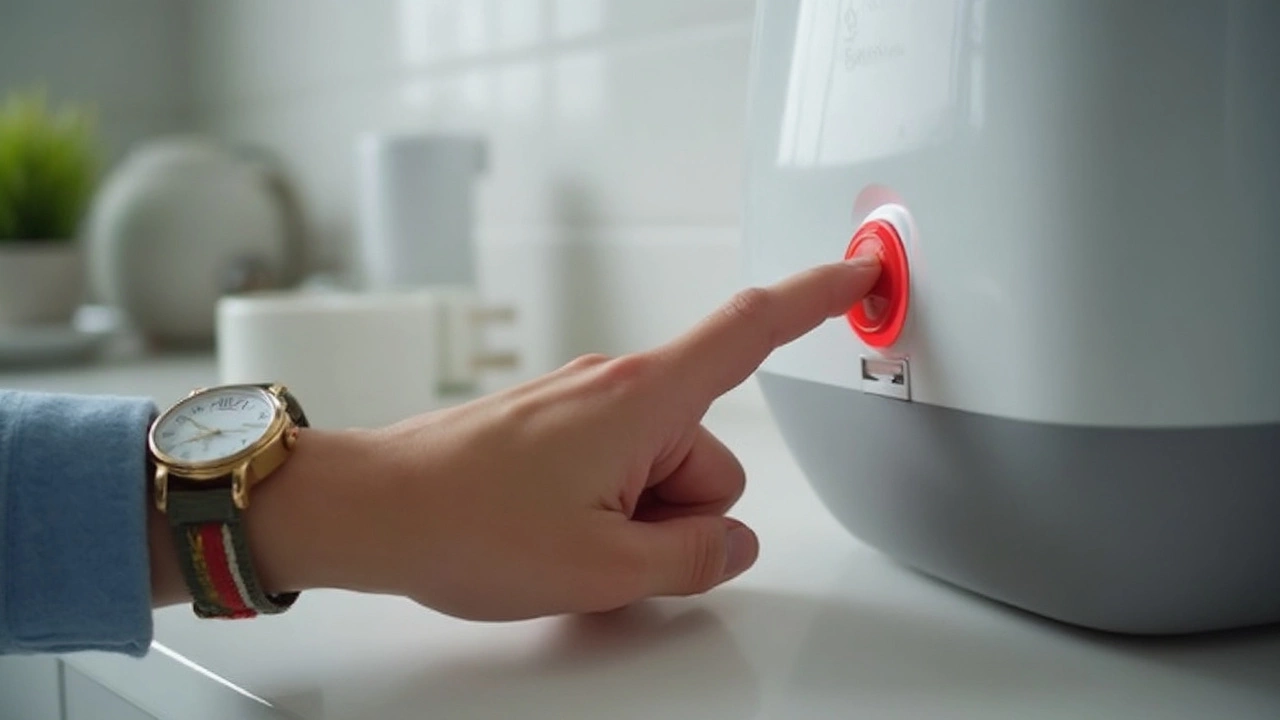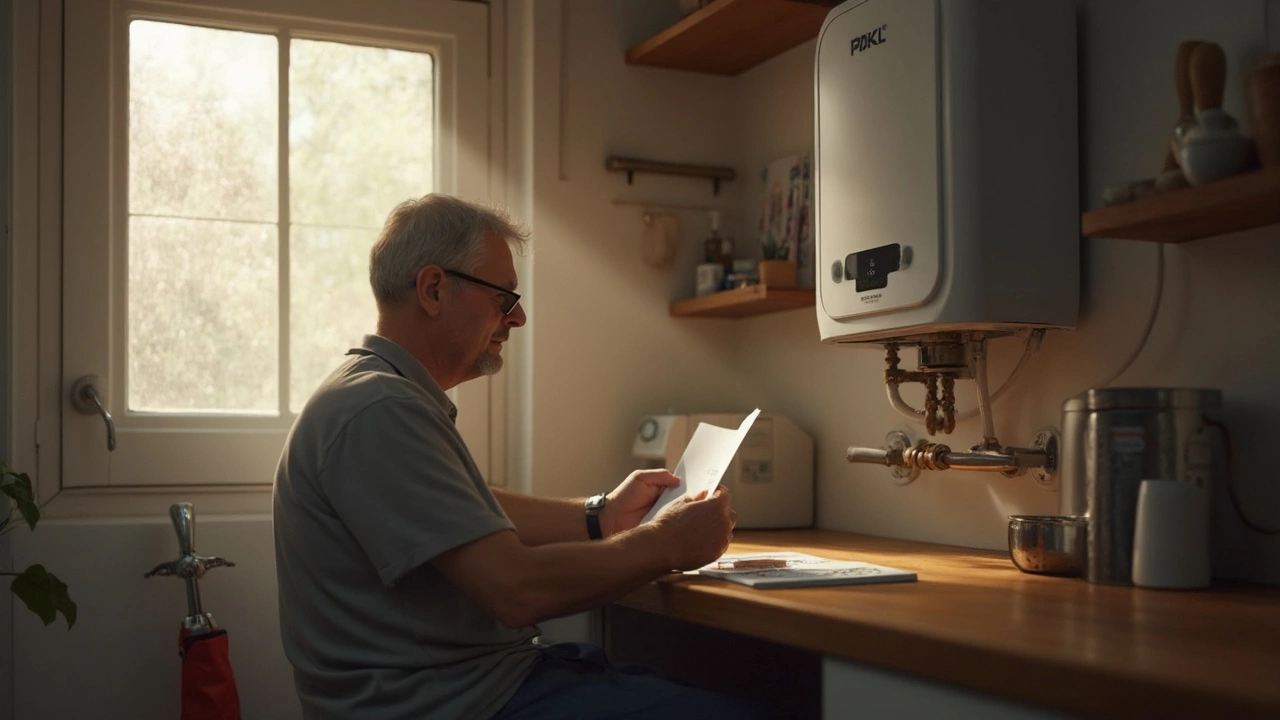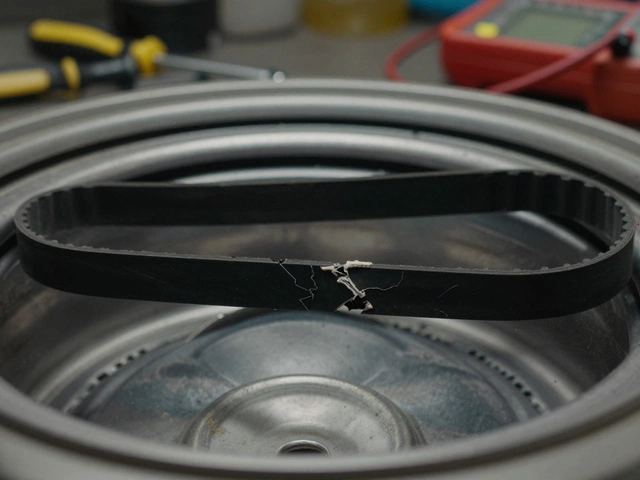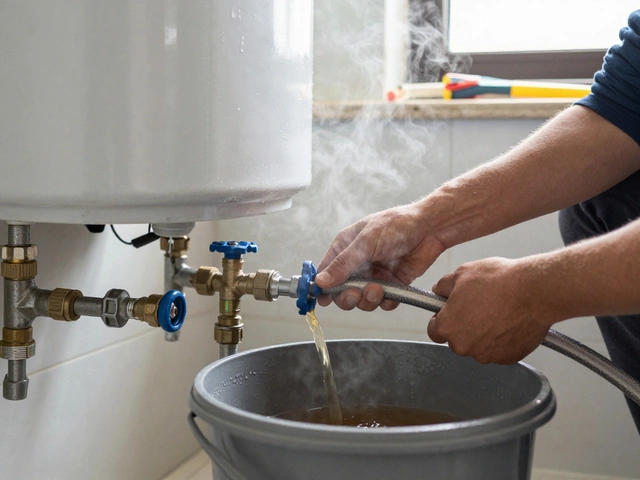Staring at a water heater that won’t kick on can be pretty frustrating. That little red or black reset button holds all the hope in the world—but do you just tap it, hold it down, or what? If you get it wrong, you might think you broke something, but honestly, it’s dead simple if you know what to do.
Pushing the reset button on a water heater usually means holding it down for about three seconds. You don’t have to put your whole back into it—just a firm press until you hear or feel a little click. That’s the thermal switch resetting inside. No complicated clock-watching needed.
After pressing it, give it a minute. If your water heater’s issue is minor and the button was really the problem, you should hear the tank start humming or click into action. Still nothing? Then the reset isn’t your fix, and going in circles with the button won’t help. Before you jump into replacing expensive parts, check the next steps in this guide to see if there's something easily overlooked causing trouble.
- Why Water Heaters Have a Reset Button
- Where to Find the Reset Button
- Step-By-Step: Pushing the Reset Button
- What Happens After You Press Reset?
- Common Mistakes and How to Avoid Them
- When the Reset Button Won’t Fix It
Why Water Heaters Have a Reset Button
If you’ve ever wondered why water heaters need a reset button in the first place, here’s the deal: it’s a basic safety feature. Most electric water heaters have a reset button built right into the thermostat. This button is there to trip if things get too hot or something inside goes sideways. Basically, it’s a way to shut the unit down before it turns into a bigger problem.
The main job of the reset button is to cut power if the water temperature climbs past safe limits—usually around 180 degrees Fahrenheit. When the thermostat or one of the heating elements malfunctions, water can overheat fast. The reset button flips off the circuit to stop the tank from turning into a big, pressurized kettle.
Besides overheating, other issues like electrical surges or sudden power outages can also make the safety switch pop. It’s not just a one-and-done solution, though. If your water heater keeps tripping the reset, it’s telling you something’s up, and you should look at possible problems, like a bad thermostat, faulty wiring, or mineral buildup on the element.
Most brands, including Rheem, AO Smith, and Bradford White, stick with having a reset button because state and federal building codes require it. This isn’t just a product choice—it’s about keeping your house safe and keeping your water heater from cooking itself to death.
Where to Find the Reset Button
If you’ve never gone poking around your water heater, you might not know where the reset button is hiding. For most modern electric water heaters, the water heater reset button is easy to find once you know what to look for. It’s almost always on the side of the tank, under a removable panel—sometimes labeled “Reset” or just a red square button.
Here’s where you’re most likely to find it:
- Electric water heaters: The reset button sits behind an insulated metal cover, usually halfway down or toward the top of the heater. You’ll need a screwdriver to pop the cover off—don’t worry, this isn’t difficult. Underneath, you’ll see foam insulation. Just peel it back to reveal the button.
- Dual-element heaters: If your heater has two thermostats, you might find two panels. The upper panel almost always hides the reset button; lower covers rarely do.
- Gas water heaters: These usually don’t have the same style reset button. They use different safety switches. This guide focuses on electric models.
Every brand does things a bit differently, but here’s a quick cheat sheet:
| Brand | Typical Location | Button Color |
|---|---|---|
| Rheem | Upper panel | Red |
| A.O. Smith | Upper panel | Red or black |
| Bradford White | Upper panel | Red |
| GE | Upper panel | Red |
One last tip—never try to find the reset button when the power is still on. Flip the breaker off at your household panel first. It’s a five-second safety move that makes a big difference.
Step-By-Step: Pushing the Reset Button
If you’re ready to get hands-on, here’s how you actually reset your water heater without making things worse. Doing this right can save you a call to the repair shop and maybe even your shower plans.
- Turn off the Power: Find your breaker box and flip the breaker for the water heater to OFF. You don’t want to mess with electric parts while the power’s still rolling—that’s asking for trouble.
- Access the Reset Button: Most electric water heaters have a removable panel—usually near the top. Remove this panel (a Phillips screwdriver should do). You’ll probably see a layer of insulation; peel that back, and the reset button (usually red, sometimes black) should be staring at you.
- Press and Hold: Here’s what matters—don’t just tap it. Firmly press and HOLD the water heater reset button for about 3 seconds. You should feel or hear a click. That click means you’ve reset the safety switch. No click? Push just a little more pressure, but don’t jam it—if it still doesn’t budge, something deeper’s up.
- Put It Back Together: Replace the insulation and screw the access panel back in place. Quick and simple. No need to over-tighten.
- Restore Power: Now, head back to the breaker panel and flip the breaker for the water heater to ON. Your heater should start humming again quickly if the reset worked.
If you notice your water heater is still completely silent after this, don’t bother hitting the button over and over. That’s usually a sign that there’s a real electrical fault or a bigger issue like a broken heating element.

What Happens After You Press Reset?
So you’ve just pressed the reset button on your water heater. If the fix worked, here’s what you can expect next. In most cases, once you press and release the reset, the heating elements get power again. Now, this doesn’t mean you’ll have hot water instantly. Even if everything’s running smooth, it still takes about 30 to 45 minutes for an average electric tank to heat up after a reset.
Listen for a faint click or hum—that’s a sign power’s restored to the heater. When things are working right, the tank may make gentle noises as water starts heating. Some heaters even have an indicator light that comes back on, letting you know it’s alive and kicking again.
If you’re still not sure what should happen, here’s a solid quote from the U.S. Department of Energy:
"After the reset button on an electric water heater is engaged, electricity should flow to the heating elements, allowing the water to begin the reheating process. If this doesn’t happen, further troubleshooting is needed."
If nothing changes after the reset, something else is likely wrong. Either the button didn’t stay engaged, or you’re dealing with a deeper electrical issue—could be a burnt-out thermostat, a blown fuse, or in rare cases, a dead heating element.
If you want a real-world sense of what to watch for post-reset, here’s a quick comparison:
| Status After Pressing Reset | What It Means |
|---|---|
| Click or hum heard, tank starts heating | Reset was successful. Water should heat up. |
| Indicator light turns on | Heater is getting power. Working as expected. |
| No noise, no lights | Electrical issue, probably not the reset button. Check breaker or wiring. |
| Button instantly trips again | Serious issue; most likely overheating or a faulty part. Stop and call a pro. |
Don’t keep pressing the reset if it keeps popping out. That button is a safety device—if it won’t stay in, there’s a real issue somewhere, and it’s just doing its job. In that case, you need troubleshooting, not more button mashing.
Common Mistakes and How to Avoid Them
The reset button on your water heater seems simple, but a lot can go sideways if you don’t pay attention. Folks often waste time or cause small problems to snowball because of these classic slip-ups.
- Water heater reset button gets pressed repeatedly. If you push it over and over, you’re stressing the safety switch. A normal reset just needs one steady press (about three seconds). More than that is pointless and might signal a bigger electrical issue.
- Not cutting the power before fiddling with the panel. Working on a live water heater isn’t just risky—it’s asking for a shock. Make sure the breaker is off before you open any covers.
- Skipping a basic check for leaks or wet wires. If water is where it shouldn’t be, that’s a fast track to electrical shorts. Give things a once-over before hitting the button.
- Ignoring a reset button that keeps popping out. If you reset and it trips again soon after, something’s wrong. This might mean a busted thermostat, burned-out heating element, or even wiring issues. Resetting won’t fix those.
- Forgetting to check the temperature dial. Sometimes someone bumps it way too high by mistake. When set above 120°F, it can cause overheating and constant tripping.
To put it into perspective, here’s a quick look at what usually goes wrong and what it means:
| Mistake | What Can Happen | How to Avoid |
|---|---|---|
| Pressing reset many times | Wears out switch, ignores real problem | Reset just once, troubleshoot further if problem continues |
| Not turning off power | Shock hazard, possible damage | Always flip breaker before working on heater |
| Skipping leak check | Short circuits, ruined parts | Inspect for wet spots or drips first |
| Reset keeps tripping | Worn out electrical parts, higher costs | Call a pro—stop resetting over and over |
| High temp setting | Frequent tripping, scalding water | Keep thermostat set around 120°F |
The bottom line? Don’t just mash the reset button and hope for the best. If you hit a snag, it’s usually a sign that your water heater needs a fix, not just a quick push. Pay attention, and don’t be shy about calling in help if things keep going wrong.
When the Reset Button Won’t Fix It
So, you’ve held the water heater reset button firm, felt the click, and nothing changes. Don’t keep banging on the button. If the tank stays cold or the breaker keeps tripping, it’s usually a bigger issue than a one-and-done fix.
Here’s what could be stopping your water heater from firing back up, even after a reset:
- Broken heating element: Electric water heaters have heating elements inside, and these burn out with age. A busted element makes your tank useless for hot water no matter how many times you reset it.
- Bad thermostat: If the thermostat is faulty, the heater can’t “read” the water temperature, so it shuts itself off as a safety move. That triggers the reset button. If you hit reset, nothing changes until a pro swaps out the thermostat.
- Tripped circuit breaker: Check your main panel. If the water heater breaker trips right after resetting, there’s a likely short or electrical fault that needs attention from an electrician.
- Loose wiring: Sometimes, wires work loose from vibration or shoddy installation. Even a slightly loose wire connection can keep your heater lifeless or even fry the reset switch.
- Lime or mineral buildup: Hard water can leave a thick scale on heating elements. That forces the element to run hot and often triggers the high-limit switch that stops things to prevent overheating.
Not sure what the most common breakdowns look like? Here’s a quick breakdown based on what plumbers see each year:
| Issue | How Often It Occurs (%) |
|---|---|
| Burnt-out heating element | 38 |
| Failed thermostat | 27 |
| Tripped breaker/faulty wiring | 20 |
| Scale/mineral buildup | 10 |
| Internal tank failure | 5 |
One thing almost everyone forgets: If the reset button keeps popping even after you fix parts, the underlying problem could be the tank itself has failed—especially if it’s over 10 years old. Water seeping around the bottom or rusty water from the tap are sure signs it’s time to stop repairing and start shopping.
Bottom line: If resetting doesn’t get your hot water flowing again, don’t just guess at the problem. At this point, calling in an actual licensed pro saves you money and hassle. It’s safer, and you’ll dodge a ton of headaches. And whatever you do, don’t bypass the reset button for a temporary fix—there’s a reason it clicked off in the first place.









